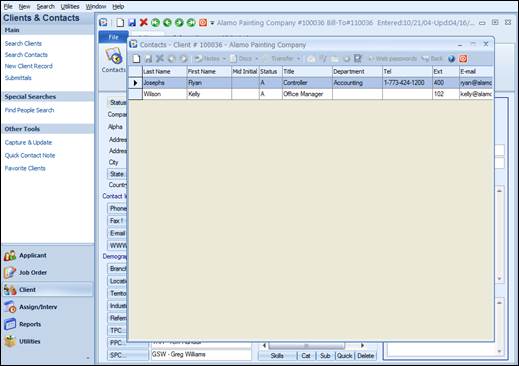
Understanding the features within Client Contacts will improve Contact documentation and elevate consistency of information.
Client Contacts in Ultra-Staff provides a comprehensive vehicle to record all types of interaction and correspondence with your Clients. From the documentation of telephone calls and e-mails, to the use of standardized letter templates and a container for attachments, the Contact Manager feature enables users to input, save and retrieve historical data about your Client Contacts. This chapter explains the many features and benefits of using Ultra-Staff’s Contact Manager.
|
1 |
The Contact Manager holds a complete history of all types of contact between the Contact and your internal Consultants. Accurate documentation enables searching of Contact information by Call Reasons and Types, Contact and Follow Up dates. Additionally, the Contact Log allows you to view the Contact Manager entries in one compact display. There are many other features within the Contact Manager that allow you to customize the information needed to provide superior service to your Clients and Contacts. All of these features will be explained in this section.

Existing Client Contacts List accessed from Client Ribbon Bar
|
1 |
To access existing contact records, click on Contacts in the Ribbon Bar. Each contact has an individual record which allows the input of specific data and provides for documentation of all interaction with that particular contact.
Each Contact line displays the following columns: Last
Name, First Name, Status, Title, Department, Telephone, Ext. and E-mail.
Contacts listed can be displayed by clicking on the desired contact line.
To add a new contact, click the New
icon. For Online Help about the Contact Manager, click the Help option. To close, click the
Close option. All other
options are inactive on the contact list screen. When you go into the
individual’s contact form, the remaining commands become active. The
Ultra-Staff Contact Manager has many options and features which will aid
in the storing and retrieving of client contact information. A grid format
is  employed, making
it easier for data entry and viewing.
employed, making
it easier for data entry and viewing.
The Contact record is divided into two areas; the top portion, the Contact Header, contains the individual contact information, and the lower portion, the Contact Detail, is used for the contact’s Owner information. The Owner is defined as the Consultant who is working with the contact.